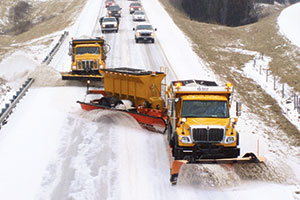Snowy States Rely on Trucks to Counter Mother Nature

This story appears in the March 2 print edition of Transport Topics.
(Editor's note: Transport Topics is closed March 5 due to the storm affecting roads in the Washington, D.C., area where our home office is located.)
While snow is sometimes viewed as the enemy of trucking, when it comes to moving goods over highways, trucks also are the primary weapon for state and local governments to fight winter’s blowing flakes.
More than 70% of the nation’s roads are in snowy regions, according to the Federal Highway Administration. And managers of public fleets sound very much like their private-sector counterparts:
“It’s been a tough one,” said beleaguered Marc Valenti, superintendent of highways, equipment and drains for the town of Lexington, Massachusetts.
Small, historic Lexington has just 150 lane-miles of road and 40 to 45 municipal trucks at its disposal for plowing. It has access to the same number of trucks from private contractors, and this season, they’re all being run ragged.
“This season, Mother Nature has decided to accelerate our snow season and compress it into four weeks,” Valenti said.
Fifty inches of snow in a winter is normal for Lexington, he said, but so far, 95 inches have fallen there through Feb. 23. At that rate, worries abound, ranging from budgets — state and local governments spend about $2.3 billion annually to clear snow on highways, FHWA said — to labor and spec’ing trucks for purchase, as well as maintaining the vehicles.
Valenti and other managers said their truck of choice is a Class 8 dump truck that can be outfitted with a 12-foot front plow and a 10-foot wing plow, or tow plow. A sand or salt spreader in the back is another typical accessory.
Such a rig costs about $250,000, said Richard Nelson, an American Association of State Highway and Transportation Officials coordinator for a snow and ice program. Come summer, plow attachments are stored, and these vehicles often do road maintenance or landscaping work.
As for how many trucks to buy, Nelson said a DOT’s purchase is based on the number of employees, not the largest possible blizzard.
“You don’t buy for one event in 100 years; equipment is expensive,” Nelson said. “A state or city bases truck purchases on average winters and then secures surge capacity during the worst of times from private contractors.”
Nelson said states sometimes smooth out their emergency workload by sharing with other states. A former official with the Nevada DOT, Nelson said his state sent trucks to California after an earthquake.
During February, Pennsylvania was among the states that sent DOT truck crews to Massachusetts to assist in blizzard recovery.
Municipal trucks in West Des Moines, Iowa, use electronic logging to record time and location of plowing and the type of material applied to a road, said Bret Hodne, the city’s public works director.
The city snow trucks are typically in the Baby Eight range — or Class 8 but not rated for 80,000 pounds, gross.
Snow operations require substantial torque for the weight involved, but at slow speeds. Hodne specifies 9.3-liter, 350-horsepower engines for the West Des Moines tandem-axle trucks and 7.6-liter, 290-horsepower engines for single-axle trucks. Fully automatic Allison transmissions are preferred, he said.
The municipal fleet also has to face environmental regulations. Once plowed, snow used to be dumped into rivers. However, the solid debris in the snow is another matter. Hodne said his people have found wooden pallets and car batteries in the drifts created by plowing. Therefore, the snow that gets hauled away usually is left on vacant lots to melt.
A common strategy for the municipal fleets is to have city trucks do the plowing and private contractors haul away the drifts.
Take Fargo, North Dakota, where the drifts can generate 400 truckloads of snow per night. Benjamin Dow, the city’s director of operations, said 50 inches of snow is typical for Fargo, but in bad years, it tops 100 inches — often accompanied by 40 mph winds.
“Those are pretty intense. It seems the trucks never get shut off except for maintenance,” Dow said.
North Dakota’s oil and gas boom has had two major effects, Dow said. He can afford bigger trucks now because of more revenue and greater needs, but it’s also harder to recruit new personnel. Established employees tend to stick with the city, Dow said, but the lure of oil wages makes it tougher to recruit new ones.
Back in Lexington, Valenti said there are many mounds of snow in excess of 2 feet. He and other city managers worry about flooding, should there be a sudden melt, so they work on keeping storm sewers clear.
Snow usually continues until mid-March, and it can happen in April, Valenti said. He really wants the stuff gone by St. Patrick’s Day, though, so his crews can prepare for Patriots’ Day on April 20.
“That’s big for us,” Valenti said. “We have a lot to do for our re-enactments of the Battle of Lexington and the Midnight Ride of Paul Revere. We want the grounds in tip-top shape for that,” he said.




